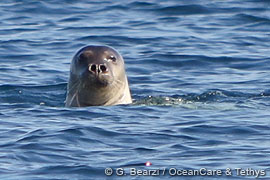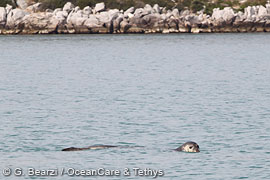

 |
||
 |
||
Vol. 13 (2): December 2010 |
||
Three monk seal encounters in the
|
 |
 |
|
|
Monk seal sighted between Arkitsa and Livanates (Northern Gulf of Evia, Greece) |
Monk seal sighted near the island of Gaidaros (Northern Gulf of Evia, Greece) |
A second encounter occurred on the following day near the island of Gaidaros in the Gulf of Atalantis, about 12 km south-east of the first sighting. This animal appeared slightly different from the first one based on photographic evidence, but such evidence was considered inconclusive. The seal was observed for about an hour engaging in food search in a shallow murky bay, not far from a fish farm and an old loading platform. He/she performed dives approximately 4-6 min long, followed by ventilation sequences of approximately 30 sec. At the surface the seal was swimming calmly, staring at us from time to time. The animal did not seem wary of our motionless boat, and never came closer than 30-50 m. We thought this was a wise behaviour, considering that monk seals are sometimes seen as vermin and shot (a recent case was reported in the Northern Gulf of Evia, see: http://www.monachus-guardian.org/mguard25/2521covsto.htm).
Our third encounter occurred on October 9th near the small island of Strongyli, about 22 km west of the place where we encountered the first seal. This animal was seen for a short time on a wavy sea and we could not manage to take photos. The seal performed a few surfacings in an area that was being intensively fished by a number of purse seiners, not far from boats setting and hauling their nets.
We have been studying coastal dolphins in various parts of Greece for two decades, totalling 116,000 km of navigation effort, but over the years we had precious few encounters with monk seals: namely 12 sightings between 1991 and 2010, all in the Inner Ionian Sea Archipelago. Three encounters in the Northern Gulf of Evia in three days gave us the first impression of a high density of monk seals. But maybe it was just a matter of chance and we can’t even tell whether our encounters were with the same individual. Subsequent navigation effort in search of dolphins throughout the Gulf in October 2010, totalling 1,343 km, did not yield more sightings of this critically endangered marine mammal.
The views expressed by outside contributors do not necessarily reflect those of The Monachus Guardian.
|